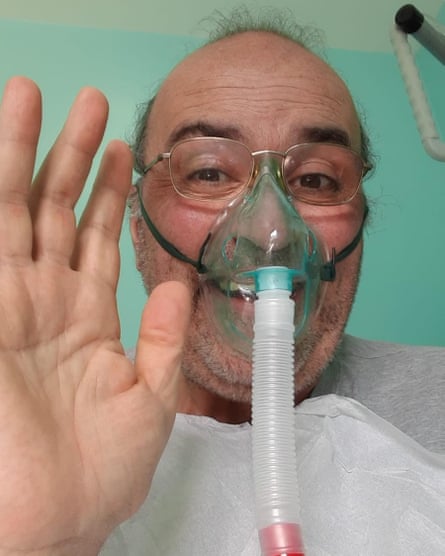Calls are growing in Italy to prioritise the vaccination of priests against Covid-19 as the death toll among members of the clergy, many of whom have assisted and comforted the sick since the beginning of the pandemic, approaches 270.
Dozens of dioceses, religious groups and priests have in recent weeks expressed support for a call for priests to be prioritise from the archbishop of Reggio Calabria, Giuseppe Fiorini Morosini, who in January told an interviewer that the church was continuing to lose clergy to the disease.
“When we discuss vaccinating people who are at risk, why aren’t the clergy included? We are closely tied to the community, assisting the sick and making social visits,” he said in an interview reported by the weekly magazine Avvenire di Calabria.
“I have the impression we are viewing the church increasingly as an entity that gives, but we never ask what it needs to carry out its mission.”
Riccardo Benotti, writer and journalist for the Italian Council of Bishops’ press agency AgenSir has tallied the victims in his recently published book, Covid 19: Priests on the Front Line, and puts the death toll among priests at 265. “The second wave was more lethal than the first, killing over 60% of [infected] priests,” he told the Guardian, adding that as the economic crisis caused by the pandemic grew people started knocking on church doors.

“Who was going to look after the homeless people searching for a meal and a place to sleep?” he asked. “Who was going to comfort the sick who wanted someone by their side? Despite the fact that members of the clergy tried to follow anti-transmission guidelines, they couldn’t refuse to hold the hands of people who were sinking.”
Father Enzo Volpe, 51, is one of those who was infected. Lying in a bed in the semi-intensive care ward in Palermo’s Cervello hospital, his fingers scroll through the names of 10 priests who have died of Covid-19 in the last eleven days as reads the latest news on his mobile phone. “It’s a tragedy,” he said.
The priest worked on the streets of Palermo helping the poor and victims of trafficking. “We were careful. We followed all of the precautionary measures from the beginning. But this virus is stealthy and can strike anyone.”
He celebrated mass on 31 January and shortly after began to develop a fever and breathing problems. When his swab test came back positive, his condition had already worsened and he was taken to hospital.
“When I was taken to intensive care, it was tough,” he admits. “But I continued to pray, to keep the faith, wondering how I contracted the disease in the first place.”
In many of the country’s red zones, those at high risk of outbreaks, cinemas, museums, gyms and schools have remained closed. But not churches, as priests have continued to carry out duties like celebrating mass and administering last rites.
During the first wave, religious authorities prohibited weddings and baptisms, and for a short period even funerals. They also required that the Eucharist be distributed into the hands of the faithful and that handshakes be avoided. Masks were made mandatory and church capacity was halved. However, such restrictions were not enough to safeguard the clergy.
In Bergamo, the city that paid the highest price during the first wave of the pandemic, nearly 30 priests died, 24 of whom over two weeks last March.
The virus didn’t spare the hundreds of convents and monasteries, where elderly nuns and friars share common spaces.
In late March 2020, 16 friars at the monastery of Xaverian Fathers in Parma succumbed to the disease. The most recent outbreak at the monastery of Monte Berico, in Vicenza, took the lives of eight friars. In mid-December, 104 of the 114 nuns living in a convent in the town of Bagnoregio, just north of Rome, tested positive for Covid-19. Twenty-six nuns died over a few days between December and January, 10 of whom in an assisted living facility near Ravenna.
It is difficult to establish the precise number of victims of friars and nuns, because, unlike priests, they belong to different congregations which are difficult for the Vatican to monitor. Nonetheless, media reports believe the number to be higher than the estimated almost 270 for priests which, at this pace, could soon match the 300 Italian doctors who have died from Covid during the pandemic.
One risk factor is the increasing age of the Italian clergy as dwindling numbers of young people enter it. According to data from the Central Institute for the Support of Clergy, the average age of parish priests in Italy is 62. Since 1990, the percentage of priests over 70 has risen from 22.1% to 36%.
While the maximum age to carry out the functions of parish priest is 75, many priests have continued to perform their duties beyond that limit, even during the pandemic.
“Doctors are physicians of the body, I’m a doctor of the soul,” said Don Casardi, a parish priest in Rondissone, Piedmont, during a mass on 31 January. “I’m elderly and always around people. I call upon the authorities to intervene and vaccinate priests. Even if I wear a mask, use hand sanitiser and follow all of the law’s prescriptions, I’m still at risk.”
“We couldn’t use Covid simply as an excuse to do nothing,” says Father Enzo. “It is precisely in these moments that our ministry is most needed.”
